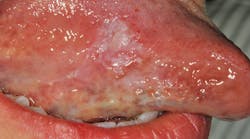Case history
This is a case of a healthy, 26-year-old female who presented to my office for treatment of an implant affected by moderate peri-implantitis. She had a noncontributory medical history, was taking no medications, and had no stated food or drug allergies. She denied the use of tobacco products, alcohol, vaping, and drugs.
Clinical examination
Upon oral mucosal inspection, a 15 mm x 15 mm leukoplakic lesion was detected on the right lateral border of the patient’s tongue (figure 1). The patient stated that she knew about the lesion for the past few months and attributed it to “constantly biting her tongue.” Because of the length of duration of the lesion and its location, a biopsy was suggested.
Differential diagnosis and discussion
A differential diagnosis was given to the patient that included trauma, frictional keratosis, lichen planus, lichenoid lesions, rhomboid glossitis, squamous cell carcinoma (SCC), and other malignancies such as lymphoma and sarcoma. The patient and her mother denied the biopsy and left the office quite upset, as they thought that they “were only there to get the implant treated.”
A few months later, the patient’s mother called the office to let us know that her daughter had visited an ENT, had the lesion biopsied, and the diagnosis came back as oral squamous cell carcinoma of the tongue. A hemiglossectomy was performed, and the patient was expected to make a full recovery as the carcinoma was in situ, had not broken through the basement membrane, and had not metastasized. If metastasis had occurred, the prognosis for recovery would have been much worse.
Related reading: Squamous cell carcinoma: A pathology case report follow-up
Approximately 20% of all squamous cell carcinomas of the oral cavity arise from the tongue, and approximately 75% of all tongue SCCs arise from the anterior two-thirds of the tongue.1 SCC of the tongue is most common on the lateral border of the mid- and posterior tongue. Although easily detected with a thorough examination, patients may ignore these lesions because they are often painless. Further, because they present as nonhealing ulcers demonstrating growth over time, as eventual recognition occurs, SCC may be in the late stage of the disease process and a “neck mass” may be the chief complaint.2
HPV and SCC
SCC of the tongue typically has been attributed to a history of smoking and alcohol consumption and is still the biggest risk factor for this disease. However, recent studies have highlighted the role of the human papillomavirus (HPV) as a major etiologic agent for the development of SCC. In fact, HPV’s role in SCC is strongest in the oral cavity, with up to 50% having this viral origin.3 In one study, HPV presence in the oral cavity was associated with the increased risk for oral cavity or oropharyngeal cancer (odds are 3.7 with a 95% confidence interval), independent of alcohol and tobacco exposure.4 Despite the decrease in smoking and alcohol consumption among young adolescents, the rise in oral SCC in this population highlights the importance of oral cancer screening and the need for more information on HPV’s role in oral SCC.
References
- Myers JN, Elkins T, Roberts D, Byers RM. Squamous cell carcinoma of the tongue in young adults: increasing incidence and factors that predict treatment outcomes. Otolaryngol Head Neck Surg. 2000;122(1):44-51. doi:10.1016/S0194-5998(00)70142-2
- Woolgar JA, Scott J. Prediction of cervical lymph node metastasis in squamous cell carcinoma of the tongue/floor of mouth. Head Neck. 1995;17(6):463-472. doi:10.1002/hed.2880170603
- Harrison LB, Sessions RB, Hong WK, eds. Head and neck cancer: a multidisciplinary approach. 2nd ed. Philadelphia, PA: Lippincott Williams & Wilkins; 2004.
- Schwartz SM, Daling JR, Doody DR, et al. Oral cancer risk in relation to sexual history and evidence of human papillomavirus infection. J Natl Cancer Inst. 1998;90(21):1626-1636. doi:10.1093/jnci/90.21.1626







